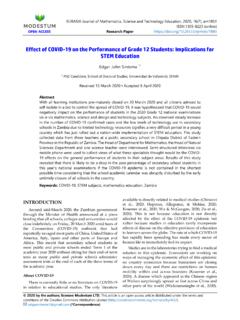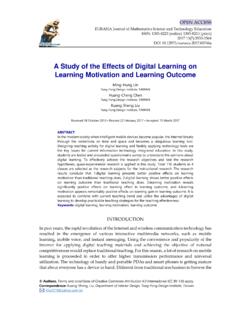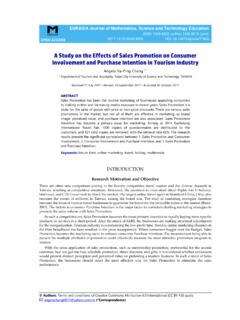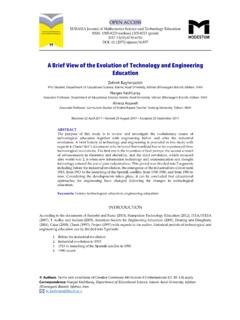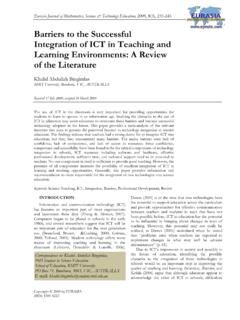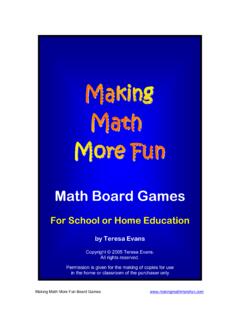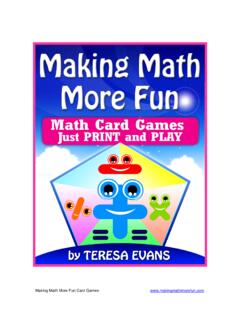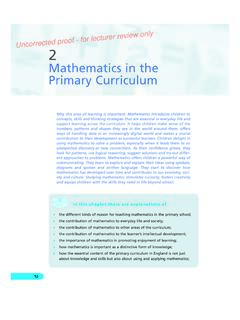Transcription of Making It Count: Strategies for Improving Problem-Solving ...
1 Authors. Terms and conditions of Creative Commons Attribution International (CC BY ) apply. (*Correspondence) OPEN ACCESS EURASIA Journal of mathematics , Science and Technology Education ISSN: 1305-8223 (online) 1305-8215 (print) 2018 14(4 ):1253-1261 DOI: Making It Count: Strategies for Improving Problem-Solving Skills in mathematics for Students and Teachers Classroom Management Nurdan zre bero lu 1*, a da K van a ana a 1 1 European University of Lefke, Lefke, CYPRUS Received 10 October 2017 Revised 15 December 2017 Accepted 18 December 2017 ABSTRACT Understanding a problem is as important as solving it to understand the meaning of mathematics . It is a widespread view that Problem-Solving skills help individuals to overcome the problems easily in their daily lives. An individual with Problem-Solving skills is a self-confident, creative and independent thinker.
2 It can be explicable that the societies formed by these individuals can easily solve the problems. In this vein, this study is aimed to determine the relationship between the acquisition of Problem-Solving skills that play an important role in mathematics alongside two dimensions of classroom management which are time management and plan-program management. It is thought that there is a close relationship between these two dimensions; Problem-Solving skills. The types of problems are divided into two; routine and non-routine. The aim is to get opinions about how these problems will be taught by mathematics teachers, at what level they will be used in class and what methods they will use for them. The study was conducted by doing a content analysis of qualitative research methods. The sample group which is randomly determined from five provinces of North Cyprus is composed of mathematics teachers who teach at the 9th grade level.
3 The data was collected through semi-structured interview forms. Content analysis technique was used in the evaluation of the obtained data. As a result, it was found out that the mathematics teachers who work in the Ministry of National Education and teach at the 9th grade, have been given importance to Problem-Solving skills such as, Problem-Solving duration and Problem-Solving methods in their classes. In addition, the teachers pointed out that the time given is not sufficient at schools and they could not give enough importance to plan-program activities. They also pointed out that although the annual and monthly plans specified by the Ministry, the desired variety of questions could not be provided by different methods. Keywords: Problem-Solving skills, non-routine problems, classroom management, time management, management of plan program activities INTRODUCTION Problem-Solving in mathematics is known to have an important place in classroom management.
4 Having considered the problems that emerge in our daily lives are a kind of problem , and Problem-Solving skills enable individuals to overcome these kinds of problems. Therefore, Problem-Solving skills, which have an important place not only in mathematics but also in our real life, should be turned into one of the 21st century teaching methods (Ocak & E mir, 2014). As a result of the literature review, the problem types used in mathematics are divided into two groups as routine and non-routine problems. The routine problems are those that are found in textbooks, the four operations are sufficient in order to be solved and that are solved in the same way by using the previously known formulas (Polya, 2014; Van de Walle, Karp, & Bay-Williams, 2013). Non-routine problems are those that are encountered zre bero lu & a ana a / Problem-Solving Skills in mathematics 1254 mostly in real life, which do not have specific formulas that can be solved by using different Strategies and categorization requiring creative thinking skills (Memnun, 2015).
5 An individual with Problem-Solving skills grows up as a self-confident individual who can think creatively and independently (G neri Y yen, Azakl , ney, & Demirci, 2017). Therefore, it can be said that individuals are able to overcome any problems easily that will arise against a society formed by individuals who have grown up in this way. Particularly in the mathematics education and teaching that will be implemented by adopting the constructivist learning approach, the aim should be raising individuals who develop Problem-Solving , creative and reasoning skills instead of a memorizing system. In this context, it will be possible to improve the independent thinking and creativity of individuals by paying attention to the fact that the non-routine problems, that is, the kind of problems that come to our minds in our daily life, are provided more.
6 In fact, non-routine problems allow individuals to think, perform reasoning, and use a mathematical language (Altun, 2005). Unfortunately, in the conducted literature review, it was concluded that the teachers did not include non-routine problems which allowed the students to analyze the problems in the classroom, to make judgements and to produce alternative ways (I k & Kar, 2011). On the other hand, it is also important for individuals to have high-level thinking skills in order to solve non-routine problems. This is not only a case of non-routine problems, but also the expected level of metacognition that students have as one of the important factors in the teaching of Problem-Solving skills. The level of metacognition that individuals possess plays an important role in helping the individual to cope with problems, to think flexibly, and to assist individuals in the selection of Strategies (Ormrod, 2003).
7 O uz (2008) stated that high-level thinking skills can be encouraged in the educational settings by the constructivist approach which is knowledge and learning theory ( andar & ahin, 2013). It was observed that the high-level thinking skills, which have not yet been described, were mentioned by Zoller (1995) and an arrangement should have been made that would draw attention to the necessity of these skills can be built on the old information that could ask questions, create, analyze and make evaluations. The acquisition of high-level thinking skills is possible only through the development of mental skills. In the context of high-level thinking skills, the steps of analysis, synthesis and evaluation that are determined in Bloom Taxonomy are closely related to thinking, questioning, analyzing and evaluating. They can be achieved through critical thinking, questioning, analyzing and creative thinking and therefore mental operations and effective use of information (Krathworld, 2002).
8 Similarly, in Lester (2013), attention was drawn to the need for high-level thinking skills to be linked to students reasoning before the implementation of Strategies to solve non-routine problems. In this context, teachers need to prepare a course content that will provide the thinking process in order to acquire high-level thinking skills. While preparing a lesson content, they should also be careful to use the clusters that students will meet for the first time to make them think from an easy level to a difficult level. Even the problems in the exam questions that will be prepared using such clusters will give students the opportunity to think creatively and critically while analyzing them (Demirel & Ya mur, 2017). Mogari and Chirove (2017), addressed the need for students to be exposed to questions in order to develop their ability to solve non-routine problems in their work.
9 They also pointed out that with these kinds of questions students will be aware of the level of their Strategies to solve problems and help them understand. Identifying the types of questions, which are mostly challenged by the students and have been supporting them to come from above, will show their positive attitude towards mathematics and provide them with confidence in the field of mathematics by the teachers addressing to the different problems of the individual s lives as much as possible (Aydo du & Ayaz, 2008). For this reason, teachers also have great responsibilities. In this regard, Polya (1973) has contributed the field in order to help teachers and revealed the 5 steps that should be followed while solving problems. Attention has been first drawn to the necessity of collecting the data, getting to the root of the problem and planning while following these steps.
10 In the implementation of this, the teachers should emphasize that it is necessary to progress in the steps of understanding path-way, modelling, verifying and expanding respectively. Having considered the solution of problems, it is seen that there is no single rule to be applied for each problem (Altun, 2005). In particular, Polya (1973) stated that, four stages of Problem-Solving process, which are Contribution of this paper to the literature Gaining the ability to solve problems is closely associated with the effective management of time. Plan-program activities have a great importance at the usage of activities which will be implemented for gaining the ability to solve problems. Teachers views for problem types which are not routine and have a great role at gaining the ability to solve problems. EURASIA J Math Sci and Tech Ed 1255 understanding the problem , Making a strategic choice about the solution, applying the selected strategy and evaluating the solution, are necessary.


